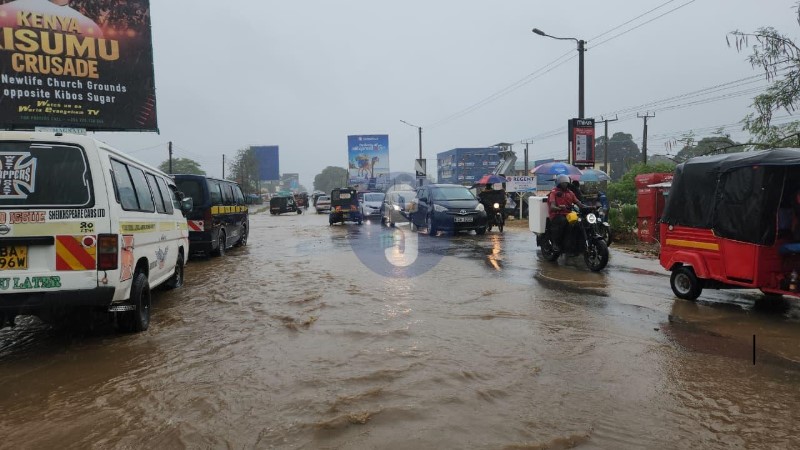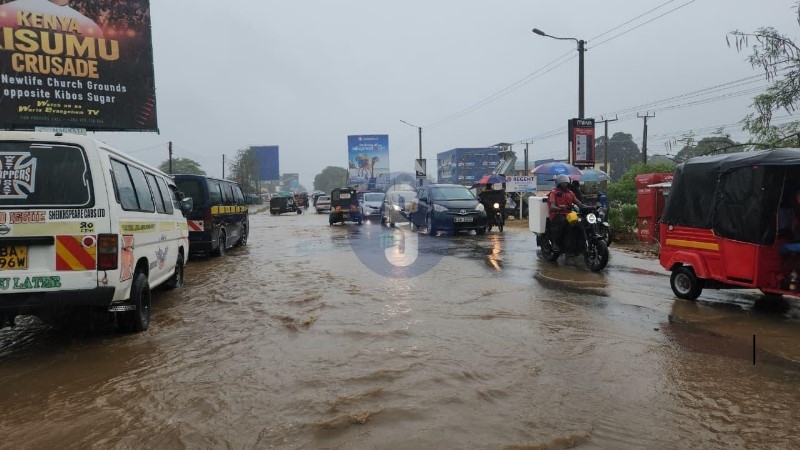
 Flooded roads following recent rains in Ukunda.
Flooded roads following recent rains in Ukunda.The Kenya Meteorological Department has warned of the likelihood of isolated flooding in parts of western Kenya, which is forecast to receive near to above-average rainfall in November.
In an update issued on Tuesday, KMD acting director Edward Muriuki said the latest weather outlook indicates continued rainfall over the Lake Victoria Basin, highlands west of the Rift Valley, and the Central and South Rift Valley.
“Highland West and East of the Rift Valley and the Lake Basin are specifically noted as likely to receive occasional moderate rainfall, requiring caution due to already saturated soils,” Muriuki said.
He said sustained rainfall in October had led to soil saturation and inundation, with the expected wet conditions in November presenting risks of rockslides, landslides and localised flooding in several western counties.
The department cautioned residents in hilly and flood-prone areas to remain vigilant as the soils can no longer absorb more water.
However, Muriuki noted that counties in the Highlands East of the Rift Valley — including Nairobi, the Southeastern lowlands, the Coast, and most of the Northeast — will receive near to below-average rainfall during the period under review.
“Rainfall will be unevenly distributed, with intermittent dry spells in several parts of the country. There is a possibility of localised floods over the western region and prolonged dry spells in the eastern parts,” he said.
He added that temperatures are expected to remain warmer than usual nationwide, a pattern that may influence both rainfall intensity and duration in affected areas.
The department has also expressed heartfelt sympathies to families affected by the Chesongoch landslides in Marakwet East subcounty, where more than 20 people lost their lives following days of heavy rain.
KMD said it continues to monitor conditions in the region closely and will issue updates to prevent similar tragedies.
As an advisory, Kenya Met said likely impacts of the forecast rain conditions include isolated flooding in poorly drained urban centres, continued landslides in hilly areas and lightning strikes in regions such as Kisii, Kisumu and Narok.
The weatherman warned against walking or driving through flooded areas and for people to avoid sheltering under trees or near grilled windows during storms to minimise the risk of lightning strikes.
For water resources, the department warned that depressed rainfall in the eastern sector may not sufficiently meet community water needs.
Residents are therefore encouraged to harvest and store rainwater while adopting efficient water-use practices.
In agriculture, the weatherman said adequate soil moisture is expected to sustain crop production in the west, though this may disrupt ongoing harvesting.
Conversely, poor crop performance is anticipated in central, eastern and coastal regions due to uneven rain distribution, making water conservation urgent in the drier areas.
For the environment, favourable soil moisture is expected in the Lake Victoria Basin, Highlands West, and Central Rift Valley.
The public is encouraged to take advantage of the short rains season and support the government's Jaza Miti initiative, which aims to plant 15 billion trees by 2032 as part of efforts to mitigate climate change.
Health authorities have also been advised to prepare for an increase in vector-borne diseases such as malaria due to stagnant water in wet areas, and for higher incidences of respiratory infections in dry, dusty regions.
"Citizens should take proactive health measures in areas with poor drainage and in dry regions," Muriuki said.
In the transport sector, the weatherman said slippery roads and flash floods could cause traffic disruptions and accidents and advised motorists and pedestrians to exercise caution during heavy downpours and avoid known flood-prone routes.
"KMD calls upon all citizens and stakeholders to utilise this climate information and advisories for planning and decision-making. The Department will continue issuing regular and timely weather updates on a daily and weekly basis," Muriuki said.





















